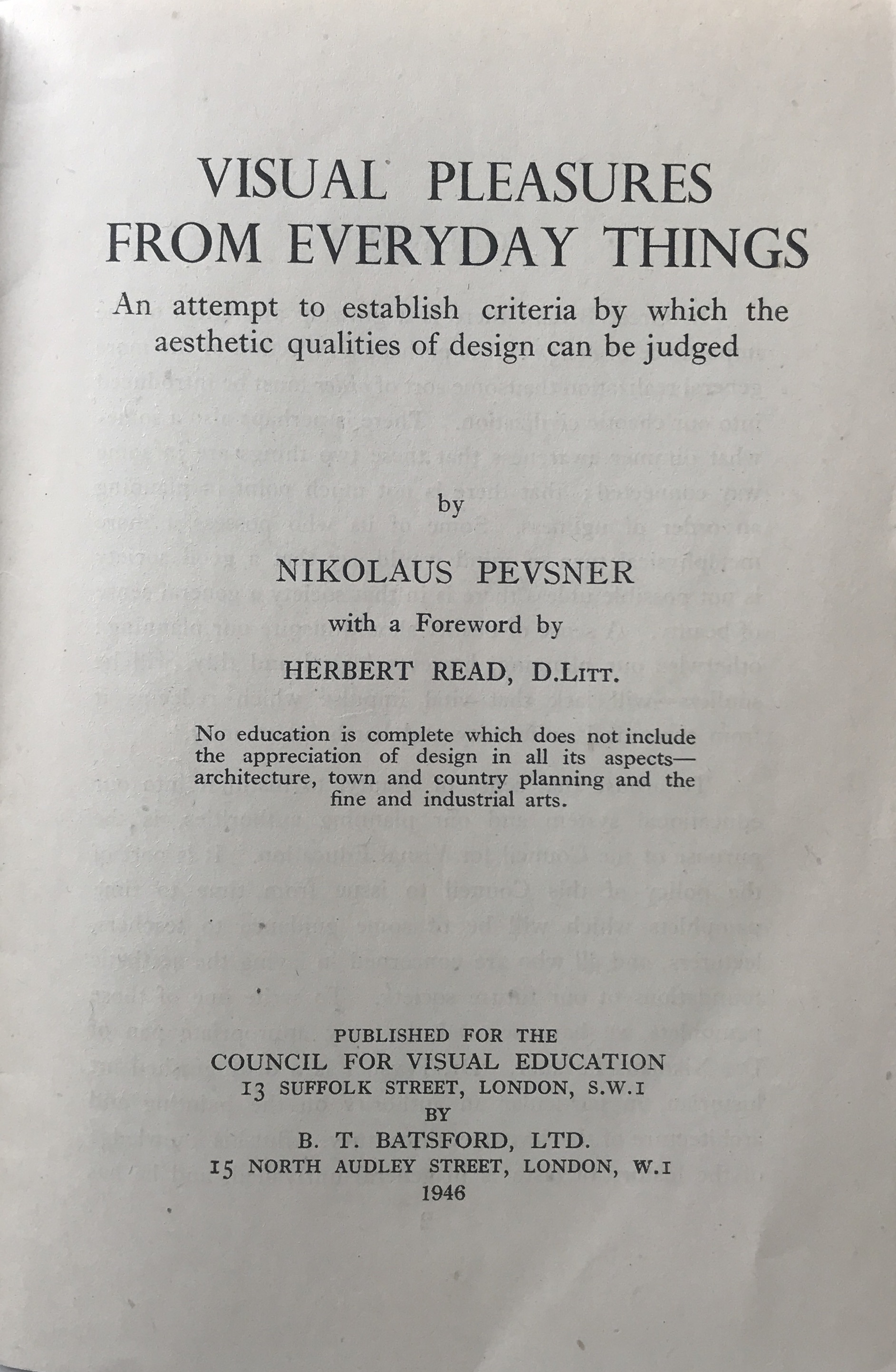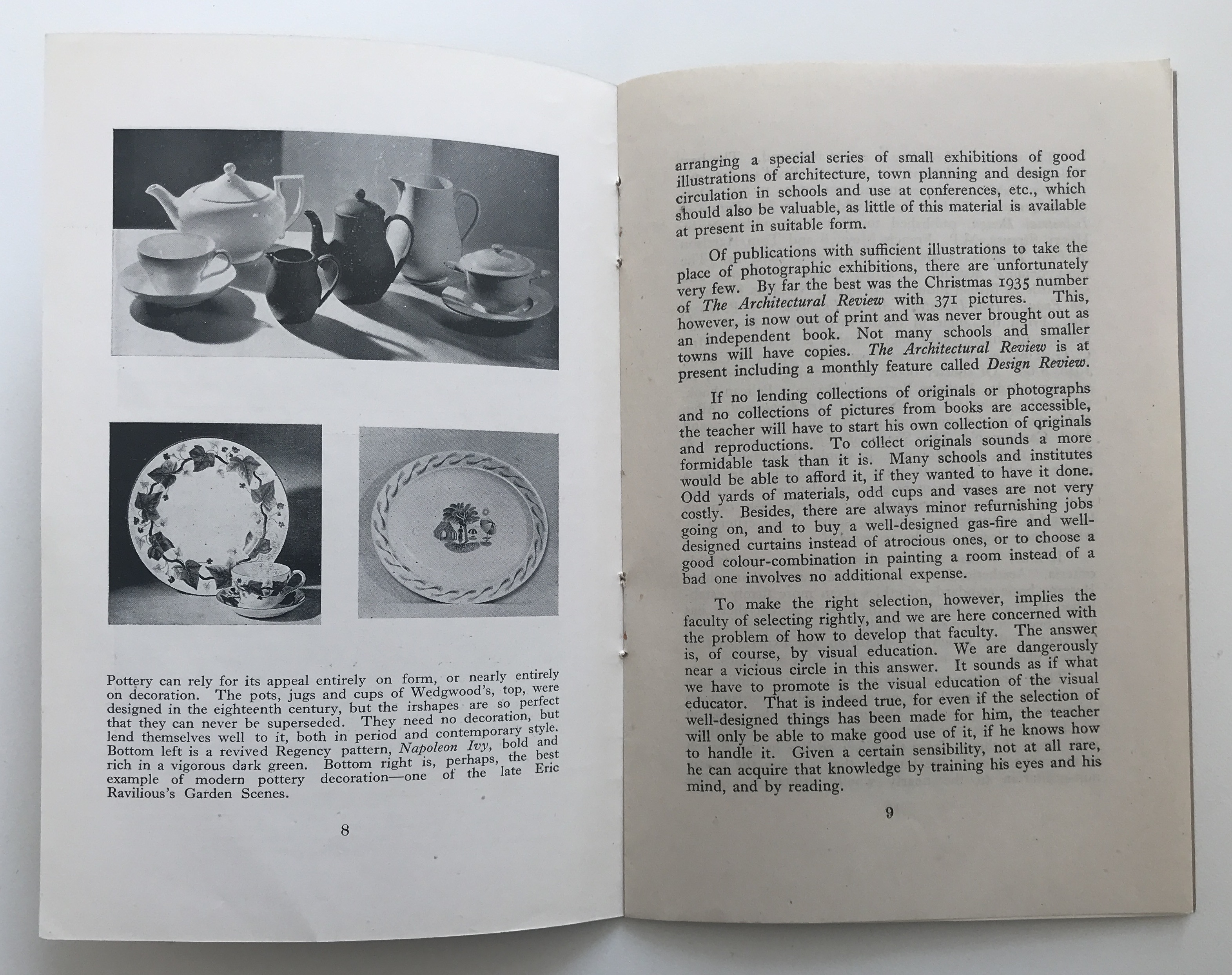Archive
Visual Pleasures from Everyday Things
- Booklet
- Visual Pleasures from Everyday Things
Word Count: 5
- Nikolaus Pevsner
- Council for Visual Education (C.V.E.)
- 1946
- 1946
Council for Visual Education, 13 Suffolk Street, West End, London SW1.
- English
18 x 12,2 cm
- London (GB)
Visual Pleasures from Everyday Things is a booklet written in 1946 by the emigrated architectural historian Nikolaus Pevsner with the aim of aesthetic education and teacher training.
Word Count: 26

Nikolaus Pevsner. Visual Pleasures from Everyday Things. An attempt to establish criteria by which the aesthetic qualities of design can be judged. Council for Visual Education (C.V.E.), 1946, cover (METROMOD Archive). 
Nikolaus Pevsner. Visual Pleasures from Everyday Things. An attempt to establish criteria by which the aesthetic qualities of design can be judged. Council for Visual Education (C.V.E.), 1946, title page (METROMOD Archive). 
Nikolaus Pevsner. Visual Pleasures from Everyday Things. An attempt to establish criteria by which the aesthetic qualities of design can be judged. Council for Visual Education (C.V.E.), 1946, pp. 2–3: Foreword by Herbert Read. (METROMOD Archive). 
Nikolaus Pevsner. Visual Pleasures from Everyday Things. An attempt to establish criteria by which the aesthetic qualities of design can be judged. Council for Visual Education (C.V.E.), 1946, pp. 8–9 (METROMOD Archive). 
Nikolaus Pevsner. Visual Pleasures from Everyday Things. An attempt to establish criteria by which the aesthetic qualities of design can be judged. Council for Visual Education (C.V.E.), 1946, pp. 14–15 (METROMOD Archive). Amery, Colin. “Nikolaus Pevsner. Pioneers of the Modern Movement from William Morris to Walter Gropius, 1936.” The Books that shaped Art History from Gombrich and Greenberg to Alpers and Krauss, edited by Richard Shone and John-Paul Stonard, Thames & Hudson, 2013, pp. 66–75.
Draper, Peter, editor. Reassessing Nikolaus Pevsner. Ashgate, 2004.
Feather, Jessica. Art behind barbed wire, exh. cat. Walker Art Gallery, National Museums Liverpool, Liverpool, 2004.
Muthesius, Stefan. “Nikolaus Pevsner (1902–1985). ” Altmeister moderner Kunstgeschichte, edited by Heinrich Dilly, Dietrich Reimer Verlag, 1990, pp. 189–204.
Pevsner, Nikolaus. Pioneers of the Modern Movement from William Morris to Walter Gropius. Faber & Faber, 1936.
Pevsner, Nikolaus. An Enquiry into Industrial Art in England. Cambridge University Press, 1937.
Pevsner, Nikolaus. An Outline of European Architecture. Penguin, 1943.
Pevsner, Nikolaus. Visual Pleasures from Everyday Things. An attempt to establish criteria by which the aesthetic qualities of design can be judged. Council for Visual Education (C.V.E.), 1946.
Pevsner, Nikolaus. “Rosa Schapire (gest.).” Kunstchronik, vol. 7, no. 4, 1954, pp. 111–112.
Pevsner, Nikolaus. The Englishness of English Art. An expanded and annotated version of the REITH LECUTURES broadcast in October and November 1955. Architectural Press, 1956.
Pevsner, Nikolaus, et al. Geheimreport Deutsches Design. Deutsche Konsumgüter im Visier des britischen Council of Industrial Design (1946) (Deutsches Museum, Abhandlungen und Berichte, Neue Folge, 28), edited by Anne Sudrow, Wallstein, 2012.
Read, Herbert. “Foreword.” Nikolaus Pevsner. Visual Pleasures from Everyday Things. An attempt to establish criteria by which the aesthetic qualities of design can be judged. Council for Visual Education (C.V.E.), 1946, pp. 2–3.
Sudrow, Anne. “Competing for a Modern Consumer Culture: German Industrial Design under Investigation by the British Military Intelligence Service BIOS.” Nikolaus Pevsner et al. Geheimreport Deutsches Design. Deutsche Konsumgüter im Visier des britischen Council of Industrial Design (1946) (Deutsches Museum, Abhandlungen und Berichte, Neue Folge, 28), edited by Anne Sudrow, Wallstein, 2012, pp. 106–118.
Waite, Richard. “Pevsner honoured with blue plaque.” Architect’s Journal, 6 November 2007, www.architectsjournal.co.uk/news/pevsner-honoured-with-blue-plaque. Accessed 25 March 2021.
Word Count: 307
The Getty Research Institute, Los Angeles, Nikolaus Pevsner papers, 1903–1982.
Word Count: 9
- London
- Burcu Dogramaci. "Visual Pleasures from Everyday Things." METROMOD Archive, 2021, https://archive.metromod.net/viewer.p/69/1470/object/5140-11267229, last modified: 01-05-2021.
-
Rosa SchapireArt HistorianLondon
The art historian Rosa Schapire, a supporter of Expressionist art, contributed to the presence of Expressionist art in England with loans and donations from her art collections rescued to London.
Word Count: 30
Julian HuxleyZoologistPhilosopherWriterLondonJulian Huxley was the director of London Zoo from 1935 to 1942 and worked closely with emigrant photographers, artists and architects, including Berthold Lubetkin, Erna Pinner and Wolf Suschitzky.
Word Count: 27
Margaret LeischnerTextile DesignerLondonThe designer Margaret Leischner lived in England from 1938, worked for textile and furniture companies, taught at the Royal College of Art and was honoured as Royal Designer for Industry.
Word Count: 29
Herbert ReadArt HistorianArt CriticPoetLondonThe British art historian Herbert Read established himself as a central figure in the London artistic scene in the 1930s and was one of the outstanding supporters of exiled artists.
Word Count: 30
Focus on Architecture and SculptureBookLondonFocus on Architecture and Sculpture by émigré photographer Helmut Gernsheim brought together his work and experience as a photographer for the National Buildings Record (NBR).
Word Count: 25
Farewell Dinner for Walter GropiusDinnerLondonFriends and colleagues came together on 9 March 1937 to send off the architect Walter Gropius and his wife Ise Gropius, who had decided to leave for the United States.
Word Count: 28
The Warburg InstituteResearch InstituteLondonThe Kulturwissenschaftliche Bibliothek Warburg in Hamburg achieved a new presence in London after 1933 under the name The Warburg Institute as a research institution with a library and photo archive.
Word Count: 29
Faber & FaberPublishing HouseLondonFaber & Faber shows the importance of publishing houses as supporters of contemporary art movements and of the contribution of emigrants, helping to popularise their art and artistic theories.
Word Count: 29
Die ZeitungNewspaperLondonFrom 1941 to 1945, the émigré German-language newspaper Die Zeitung was published in London, reporting on the war on the continent and on the situation in Germany.
Word Count: 25
The Story of ArtBookLondonThe Story of Art by the émigré art historian Ernst H. Gombrich was published in 1950 with Phaidon Press. The book is a comprehensive and accessible introduction to visual culture.
Word Count: 29